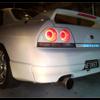Got A 3076r - Just A Conclusion
Announcements
-
Similar Content
-
Latest Posts
-
By Nightmare_mistress_R33 · Posted
Yep that is correct. It allows you to adjust the short throw range from what I can tell -
By TurboTapin · Posted
Car has been running great, I've put about 300km's of break in time on it. First thing that stands out with properly sealing rings is no more noticeable crankcase smell coming out of my catch can. This may seem insignificant, but the constant smell while driving around was infuriating. It's also nice to see my oil level remain stable. Two new issues have developed that I only noticed this weekend though. There's a very noticeable driveline vibration past 100kmh. I only noticed it now as I've been babying it under 100kmh in the backroads. This comes as no surprise as I'm running a one-piece shaft, and I paid zero attention to my driveshaft angle when I put everything back in. I also have a fair bit of voltage drop on hot starts. The starter audibly is forcing. No issues on cold start though. I must not have removed all the paint under my main block ground during assembly. I'll try and take care of both those issues this week once the kids are asleep. I also received all the parts I was missing for my direct port setup. I will hopefully have pictures of that up soon. I'm hoping to get back on the dyno the week of June 30th as I'll be on vacation. I'm confident I should be able to make north of 500rwkw on pump gas and WMI. I'll go back again later this summer with E98, but I want to confirm my ethanol content sensor is working properly first. I've never seen it read anything but 11%. This makes sense for our 10% ethanol content pump gas here, but I would expect the occasional movement between fill ups. -
75% complete. Will now need to get a new axle with 5x114.3 hubs and then figure out how to customize some mudguards for it once the wheels are on.
-
Trailer prep is underway... Lined up the wheel to get a rough indication of how it would sit Then removed all the bits (as far as possible) and gave the frame a light sand and quick lick of paint Then added some carpet
-
okay, so I figured this out, removed needles and reinstalled after swapping the gauge face on my triple gauge for my ER34, all work and look good. I tried to do the same for the main cluster, but the main cluster gauge faces are dished, the replacement gauge face are flat, so due to the dish in the org face ,mounting backing plate (clear) and depth of the needle, the flat gauge face will not work. I notice that R34 gtr gauges are flat, appears to be different clear backing plate that aren't dished. are these available, or what have others done to install flat gauge faces?
-








Recommended Posts
Create an account or sign in to comment
You need to be a member in order to leave a comment
Create an account
Sign up for a new account in our community. It's easy!
Register a new accountSign in
Already have an account? Sign in here.
Sign In Now